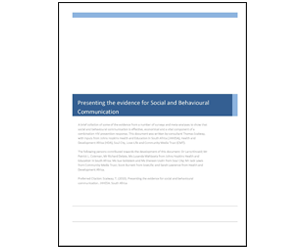A new paper, Presenting the Evidence for Social and Behavioural Communication, shows that in between the calls for access to treatment and biomedical prevention, social and behavioral prevention in South Africa is quietly but effectively contributing to the uptake of HIV prevention behaviors, averting and/or delaying new HIV infections and saving the country billions in future treatment costs.
The paper was written by Thomas Scalway with inputs from a range of social and behavioral partners in South Africa, including Johns Hopkins Health and Education in South Africa (JHHESA), Health and Development Africa (HDA), Soul City, loveLife and Community Media Trust (CMT).
How many infections are averted or delayed as a result of social and behavioral interventions? Work by Dr. Larry Kincaid, Senior Advisor to the Center for Communication Program’s Research and Evaluation Division, using the 2005 Human Science Research Council (HSRC) survey suggests that millions of South Africans have taken up prevention behaviors and that thousands of new HIV infections have been averted and/or delayed, saving the country billions in future treatment costs. Dr. Kincaid showed in his study that there is a generational shift happening with the uptake of HIV prevention amongst young people in particular, a fact that was supported by the latest HSRC survey which indicated that incidence of new infections is decreasing amongst young people.
The paper points out that social and behavioral communication cannot directly impact HIV prevalence but rather impacts the behavioral and social outcomes or ideational factors which in turn affect behaviors that prevent new HIV infections. It is also critical to remember that after close to 30 years of the epidemic, social and behavioral communication (SBC) is no longer about change – it is also about reinforcing and maintaining existing behaviors amongst the majority of the population that are doing the right thing. As is evident in the MSM population in Europe and the US – once we take our foot off the social and behavioral prevention pedal new infections start to increase. Therefore, prevention is for life just as treatment is for life.
Many of those who question the impact of social and behavioral communication point out that millions have been spent on these programmes in the past. For this reason, it is necessary to remember is that communication programmes compete within an already existing commercial market where millions of messages are sent to consumers on a daily basis by private enterprises, vying for the time and attention of the target market. SBC messages also exist within a political, cultural and social milieu. Often the messages being promoted through SBC programmes are contradicted by politicians, musicians, soap operas and movies.
SBC programmes do not market one product; rather they communicate and support behavioral and biomedical prevention, gender based violence, HIV treatment, and the list goes on. Despite this, the expenditure on SBC per year in South Africa is not even a quarter of what alcohol manufacturers spend on marketing and communication. It does not come close to the top 10% of South African private sector expenditures. Even at a mass media level it is not clear whether we have reached scale to date. Presenting the Evidence for Social and Behavioural Communication states that we are still lagging far behind with face-to-face communication interventions, as not even 5% of the population are being reached at present through “direct marketing initiatives”.
Nonetheless, programmatic evaluations indicate that interventions are having an impact; for example, condom usage has increased phenomenally over the past 20 years despite the many cynics who said it could not work. There has been a huge uptake in counselling and testing, particularly among women but more and more among men. The majority of South Africans are aware of ARV treatment and understand that treatment is for life. There are signs that partner reduction is starting to happen, though partner reduction programmes are still in their infancy in South Africa and need to be intensified and monitored over a longer period of time. All of this can be attributed to social and behavioral communication programmes.
Are these programmes cost effective? Preliminary findings from Scrutinize found that the cost per person reached through its campaign was R2.10, highly effective in relation to condom uptake, testing and partner reduction. Each additional condom user cost R50.07 which can be attributed to the Scrutinize campaign.
There are still many gaps that need to be addressed. Young women remain a concern in relation to HIV prevention. The linkages between alcohol, sex and HIV need to be further examined and promoted. PMTCT is lagging shockingly behind – it is criminal that fewer than 5% of South Africans know that exclusive breastfeeding can prevent mother to child transmission.
It has been questioned whether the techniques (self reported surveys) used to measure social and behavioral prevention outcomes are accurate. While these concerns are fair, three HSRC surveys, two national communication surveys and many smaller studies have all shown similar trends. Even if there is over reporting the trends are consistent: the more people are exposed to social and behavioral prevention the more likely they are to practice HIV prevention.
Read Presenting the Evidence for Social and Behavioral Communication.
Learn more about JHHESA.





